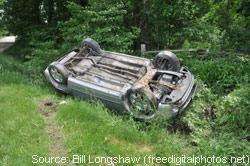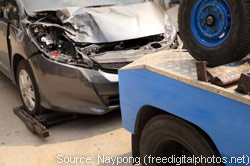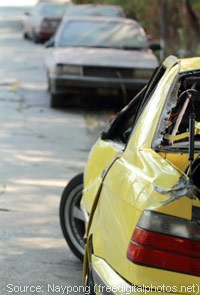 Driving is a vastly common, every day activity that is often taken for granted. Every time we get behind the wheel of our car, we become the operator of a potentially deadly weapon. Car crashes kill thousands in the United States each year, and there are a variety of factors that contribute to the likelihood of a crash. Drunk driving, speeding, texting, and poor weather can all cause a dangerous-and even deadly-collision on the road.
Driving is a vastly common, every day activity that is often taken for granted. Every time we get behind the wheel of our car, we become the operator of a potentially deadly weapon. Car crashes kill thousands in the United States each year, and there are a variety of factors that contribute to the likelihood of a crash. Drunk driving, speeding, texting, and poor weather can all cause a dangerous-and even deadly-collision on the road.
Read on for the most common causes of car accidents, as well as some helpful safe driving tips that everyone must follow to prevent them.
Speeding and reckless driving
In a nation where everyone is too busy, and always running late, driving too fast and too carelessly has become an epidemic. Failure to adhere to the speed limit is the one of the leading causes of traffic accidents in the country, causing approximately one-third of crashes according to the U.S. Department of Transportation. Speeding is extremely dangerous because it not only makes handling the vehicle more difficult, but it dramatically decreases your ability to slow down or stop if necessary. Reducing your speed, staying mindful of the posted limit, and driving with caution is the best way to reduce your risk of collision.
Drunk driving
Drinking alcohol slows reaction time, impairs vision and coordination, and greatly affects judgment. Driving under the influence is extremely hazardous, irresponsible and increases your risk of an accident by a staggering 900 percent. According to Mothers Against Drunk Driving (MADD), an estimated 300,000 incidents of drunk driving occur every day, and in 2010, over 1.4 million drivers were arrested 2010 on suspicion of driving while intoxicated. Besides the increased risk of death or bodily harm to yourself and other drivers, a DUI conviction can result in high fines, legal fees and loss of license. Remember to always drink responsibly, have a designated sober driver, or call a cab to get home safely.
Distracted driving
Declining attention spans and increased gadget use has made focusing on any one task at a time nearly impossible. Texting and cell phone use while driving is a growing problem, causing thousands of death and car crashes every year. In 2011, 23 percent of all car accidents involved cell phones-which is about 1.3 million crashes. Talking on a cell phone makes a driver four times more likely to crash, but texting increases the risk a staggering 23 times. The problem is one of special concern among teens, who spend much of the day texting and playing with their smartphones. According to the Insurance Institute for Highway Safety, texting while driving kills 11 teens each day.
 Bans on cell phone use and stringent anti-texting laws in some states attempt to eradicate the problem, but it begins with personal responsibility. Put the devices and gadgets aside for the duration of the trip and give the road your undivided attention for your safety and the safety of others.
Bans on cell phone use and stringent anti-texting laws in some states attempt to eradicate the problem, but it begins with personal responsibility. Put the devices and gadgets aside for the duration of the trip and give the road your undivided attention for your safety and the safety of others.
Other common causes of distracted driving accidents include playing with the radio, eating, applying makeup, reading directions, or searching for an item in your vehicle (probably your cell phone).
Tired driving
Fatigued driving has said to be as dangerous as intoxicated driving-it slows reaction time, affects judgment and vision, and sleepy drivers may even nod out at the wheel. The National Highway Traffic Safety Administration estimates that 100,000 crashes are caused by driver fatigue each year, resulting in approximately 1,550 deaths, 71,000 injuries, and $12.5 billion in financial loss. Driving while drowsy is also shockingly common-according to the National Sleep Foundation's 2005 Sleep in America poll, 60 percent of adult drivers (168 million people) said they drove while drowsy at least once in the past year, and more than one-third, (103 million people) admitting to actually falling asleep at the wheel.
To stay safe and alert behind the wheel, it's important to make sure you are well-rested before getting into your vehicle. Stay hydrated and eat energy-boosting foods that are high in protein, and always pull over if you feel too fatigued.
Running stop signs and traffic lights
Pushing the limits is common in our culture of speed, and many accidents are caused by failure to stop at a red light or stop sign. The challenge to speed up and beat the red light as it changes to yellow, or common pause and roll through the stop sign tactics may seem harmless, but can easily cause a severe crash. Taking the time to slow down, stop and look both ways at intersection and always yielding to a red light will keep you much safer on the road.
Unsafe lane changes
Zipping through traffic and zigzagging around other drivers to get to your destination more quickly is a dangerous and reckless practice. Unsafe lane changes can cause a variety of accidents at any moment-when many vehicles are moving at high speeds in such close proximity, it's crucial to exercise caution when changing lanes. Always use your blinker, check all of your mirrors and switch lanes slowly to limit the risk of an accident.
Poor weather conditions
Inclement weather can reduce visibility and traction, and makes driving treacherous. The likelihood of an accident is greatly increased when there's rain, snow, fog, or ice on the roads. Other drivers that are not experienced with driving in poor weather may also use bad judgment and cause dangerous conditions on the road. Always drive slowly on slippery roads, use your wipers, and turn on your headlights to stay visible to other drivers.
Lack of experience
 Many car accidents are caused by driver error due to lack of experience. Teenagers and other new drivers are much more likely to cause an accident than more seasoned drivers. If you have teens, make sure they are fully prepared before allowing them to drive on their own. Teach them to be diligent and cautious, and to never text or use a cell phone while driving. Though it will likely be met with an unfavorable reaction, you may want to limit your teen's driving after dark until you are highly comfortable in his or her ability.
Many car accidents are caused by driver error due to lack of experience. Teenagers and other new drivers are much more likely to cause an accident than more seasoned drivers. If you have teens, make sure they are fully prepared before allowing them to drive on their own. Teach them to be diligent and cautious, and to never text or use a cell phone while driving. Though it will likely be met with an unfavorable reaction, you may want to limit your teen's driving after dark until you are highly comfortable in his or her ability.
Driving at night
Though common and seemingly safe, driving at night actually doubles your risk of an accident. Your peripheral vision is limited-restricted to the area illuminated by your headlights. An animal darting into your path or another driver without his or her headlights on could cause a crash easily. Reflections from lights can sometimes affect vision negatively. Additionally, fatigue hits drivers much harder at night, increasing the hazard. To stay safe when driving at night, always use your headlights, keep your windshield clean to limit reflections, and make sure you are adequately alert to operate a vehicle before getting behind the wheel.